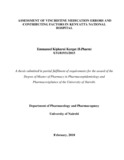| dc.contributor.author | Kurgat, Emmanuel K | |
| dc.date.accessioned | 2019-01-18T08:37:58Z | |
| dc.date.available | 2019-01-18T08:37:58Z | |
| dc.date.issued | 2018 | |
| dc.identifier.uri | http://hdl.handle.net/11295/105036 | |
| dc.description.abstract | Background: Cancer is the leading cause of death worldwide accounting for 7.6 million deaths annually. Vincristine is a cytotoxic drug used in the management of haematological malignancies and solid tumours in adult and paediatric settings. Vincristine is categorized as a “High Alert” medicine due to its narrow therapeutic index and potential to cause serious morbidity and mortality if not used appropriately. These can be avoided by addressing medication errors. Medication errors are often preventable events with potential adverse outcomes during the course of treatment with medicines.
Objective: The main aim of the study was to determine the prevalence of medication errors among cancer patients receiving vincristine as part of their chemotherapy at Kenyatta National Hospital. The secondary objective was to perform a proactive risk assessment of vincristine use process to identify medication errors contributing factors.
Methodology: The study was carried out in oncology unit of Kenyatta National Hospital (KNH). The study design was descriptive cross sectional-study with two parts, quantitative and qualitative aspects. The quantitative approach involved two phases. First phase involved retrospective review of oncology in-patient non-schedule forms and out-patient cytotoxics summary form to determine vincristine use prevalence among cancer patients attended to in the oncology out-patient clinic and in-patient oncology units between January and June 2016 whereby 2880 records were reviewed. The second phase entailed concurrent review of 241 oncology patients’ medical records on vincristine-based regimens attended to in November 2016 and March-May 2017 in the out-patient clinic and in-patient wards to identify vincristine medication errors. Descriptive statistics were used to summarize data using median, range, frequency and percentages. The qualitative component involved proactive risk assessment of vincristine use process to determine hazards to patient safety and appropriate preventive measure using Healthcare Failure Mode Effect Analysis (HFMEA). A failure mode with hazard score of 8 and higher was considered for further analysis to determine if there are any mitigation strategies in place or not. Risk mitigation strategies were developed for failure modes that didn’t have any preventive measures in place. Universal and purposive sampling was used for quantitative and qualitative phases of the study respectively.
Results: The overall prevalence of vincristine use in the out-patient department was 4% of which majority (93.4%) of the patients were adults. In the in-patient department, vincristine was administered to 36% of the admitted cancer patients on chemotherapy, most (66.9%) of them were
xvii
paediatrics. Most of the patients (62, 25.73%) had acute lymphoblastic leukaemia as the indication for vincristine-based chemotherapy. Based on the Institute of Safe Medication Practices (ISMP) and other international patient safety organisations criteria for medication errors definition and assessment, the prevalence of vincristine medication errors was found to be 99.6% [95% CI 97.1-99.9) in 241 patient medical records reviewed. The prevalence was higher in in-patients (100%) than out-patients (87.5%). Majority (81.7%) of the errors identified did not reach the patients. A medication error rate of 18.6% was also determined.
Healthcare failure mode effect analysis (HFMEA) multidisciplinary team identified 77 failure modes for the vincristine use processes of prescribing, preparation and dispensing, transportation and storage, administration and monitoring. Twelve failure modes were found to be lacking adequate control measures necessitating development of mitigation strategies for the causes.
Conclusion: The prevalence of vincristine medication errors was significantly high based on the criteria set by International Patient Safety Organisations. The hospital system for the management and follow up of oncology patients had weaknesses thus fell short of meeting the criteria hence a high degree of medication errors was observed. Despite the fact that majority of the errors observed were less likely to cause harm, some were potentially fatal thus there is need for strategies to prevent, detect and minimise these errors. | en_US |
| dc.language.iso | en | en_US |
| dc.publisher | University of Nairobi | en_US |
| dc.rights | Attribution-NonCommercial-NoDerivs 3.0 United States | * |
| dc.rights.uri | http://creativecommons.org/licenses/by-nc-nd/3.0/us/ | * |
| dc.title | Assessment of Vincristine Medication Errors and Contributing Factors in Kenyatta National Hospital | en_US |
| dc.type | Thesis | en_US |
| dc.description.department | a
Department of Psychiatry, University of Nairobi, ; bDepartment of Mental Health, School of Medicine,
Moi University, Eldoret, Kenya | |



